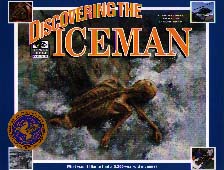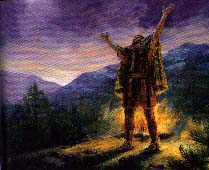


|
Discovering the Iceman: What Was It Like to Find a 5,300-Year-Old Mummy?
Shelley Tanaka. Illustrated by Laurie McGaw. Subject Heading:
Grades 4 - 6 / Ages 9 - 11.
**** /4
|

Winner of the Mr. Christie's Book Award for 1996, Discovering the Iceman is a "must have" for the information section of school libraries. Just as the story of the discovery of King Tutankhamen's tomb has fascinated young readers for decades, so will the account of the 5,300 year-old man in the ice. Tanaka's book, with its clear and straightforward text highlighted by dozens of succinctly-captioned photographs, paintings, diagrams and sidebars, gives elementary students access to one of the most thrilling archeological discoveries of our time. What is so satisfying about Tanaka's re-creation of this scientific event is that it answers virtually every question that an intellectually curious, question-a-minute young reader would be likely to ask as he/she pours over the book. The book's stunning cover painting, depicting the bare brown head and bony shoulders of the mummy lying face-down in the melting glacier, guarantees that Discovering the Iceman will not languish on the library shelf!
Highly recommended.
Val Nielsen is teacher-librarian at Bairdmore School in Winnipeg, Manitoba.
To comment on this title or this review, send mail to cm@umanitoba.ca.
Copyright © 1998 the Manitoba Library Association.
Reproduction for personal use is permitted only if this copyright notice
is maintained. Any other reproduction is prohibited without
permission.
Published by
TABLE OF CONTENTS FOR THIS ISSUE - MARCH 27, 1998.
AUTHORS |
TITLES |
MEDIA REVIEWS |
BACK ISSUES |
SEARCH |
ORDER |
CMARCHIVE |
HOME In this second title of the successful "I Was There" series for intermediate grade readers, award-winning author Shelley Tanaka delves into the fascinating question: "What was it like to find a 5,300 year-old mummy?" Discovering the Iceman is divided into three parts. Part One, "The Discovery," chronicles Austrian hikers Erika and Helmut Simon's incredible discovery in 1991, as they crossed a glacier in the Oztal Alps, of a doll-like figure sticking out of a puddle of mushy snow. When Konrad Spindler, archaeologist at the University of Innsbruck, was invited to see the body, he realized that the most exciting clue about the Iceman, as he came to be called, was the ax found near him. Spindler knew from the ax's shape and construction that the man had died at least four thousand years ago. Subsequent carbon-14 dating of the ax determined that the Iceman was 5,300 years old - the oldest human body that had ever been found so well preserved. The clothing, tools and weapons found with him were like a time capsule from the late Stone Age enabling scientists to learn more about what life was really like for our ancestors. Part Two of Discovering the Iceman, "The Iceman's Story," is an exciting narrative dealing with "how it might have been." In this section, the author imagines how the Iceman might have lived and come to die alone on a mountain ridge. To bring the story to life, Tanaka intersperses the text with Lawrie McGaw's dramatic paintings of Stone-age life as well as clearly captioned photographs and drawings. Part Three, "The Iceman and Us," describes ongoing scientific detective work on the Iceman and shows readers how such work helps to fill gaps in the puzzle of pre-history. The book ends with two exceptionally valuable features for the young reader: a time-line showing the Iceman's place in time, and a glossary of unfamiliar terms used in the book. Also helpful to those whose interest is piqued by this amazing piece of history is a list of recommended books for further reading.
In this second title of the successful "I Was There" series for intermediate grade readers, award-winning author Shelley Tanaka delves into the fascinating question: "What was it like to find a 5,300 year-old mummy?" Discovering the Iceman is divided into three parts. Part One, "The Discovery," chronicles Austrian hikers Erika and Helmut Simon's incredible discovery in 1991, as they crossed a glacier in the Oztal Alps, of a doll-like figure sticking out of a puddle of mushy snow. When Konrad Spindler, archaeologist at the University of Innsbruck, was invited to see the body, he realized that the most exciting clue about the Iceman, as he came to be called, was the ax found near him. Spindler knew from the ax's shape and construction that the man had died at least four thousand years ago. Subsequent carbon-14 dating of the ax determined that the Iceman was 5,300 years old - the oldest human body that had ever been found so well preserved. The clothing, tools and weapons found with him were like a time capsule from the late Stone Age enabling scientists to learn more about what life was really like for our ancestors. Part Two of Discovering the Iceman, "The Iceman's Story," is an exciting narrative dealing with "how it might have been." In this section, the author imagines how the Iceman might have lived and come to die alone on a mountain ridge. To bring the story to life, Tanaka intersperses the text with Lawrie McGaw's dramatic paintings of Stone-age life as well as clearly captioned photographs and drawings. Part Three, "The Iceman and Us," describes ongoing scientific detective work on the Iceman and shows readers how such work helps to fill gaps in the puzzle of pre-history. The book ends with two exceptionally valuable features for the young reader: a time-line showing the Iceman's place in time, and a glossary of unfamiliar terms used in the book. Also helpful to those whose interest is piqued by this amazing piece of history is a list of recommended books for further reading.

The Manitoba Library Association
ISSN 1201-9364